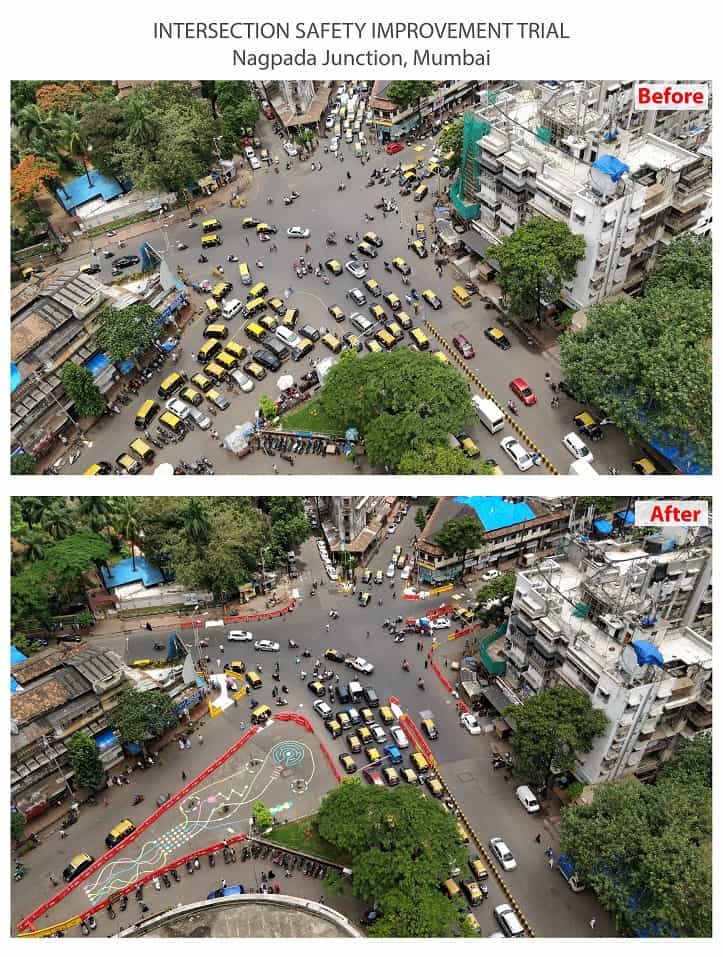India’s largest city, and the eighth largest globally, Mumbai houses more than 1.2 crore people according to Census 2011. The city traffic has a notorious image, with frequent traffic jams being reported routinely in the media. However, the Draft Development Plan for Greater Mumbai 2014-2034 conveys a different story of how the city moves.
The plan reveals that more than half of the city uses non-motorised modes of transport such as walking and cycling (51%). 42% of the trips are catered to by public modes of transport, including trains, buses, auto rickshaws etc, while the share of cars, two-wheelers and other private motorised modes is only 7%. Therefore, mobility data clearly shows that only a tiny minority travels by cars, whereas a majority of the road infrastructure is designed for them.
The result of this mismatch is reflected in the deteriorating safety and security of other road users, especially pedestrians. In 2015, of the 611 people who lost their lives on Mumbai streets due to road traffic crashes, 56% were pedestrians.
In addition, WRI India’s detailed analysis of road crash data revealed that close to a third of all road traffic fatalities in Mumbai happen at the intersections. Therefore, improving intersections can be a key strategy in the overall improvement of road safety in the city.
A small experiment at an intersection in Nagpada, following the success of trial implementation of the HP Intersection in Bandra, is intended to change the current approach of designing intersections – from designs made for motor vehicles to one that considers all road users – by using a temporary approach that promises to bring change.
Chaos at Nagpada
It had been seen over the years that pedestrians at the Nagpada intersection were being squeezed out of spaces to walk. Children and senior citizens found it particularly hard to navigate the intersection safely due to various reasons, including illegal parking.
From a traffic administration perspective, on the other hand, the Nagpada intersection, like many others in Mumbai, remained congested for the most part of the day and pedestrians were considered to hamper traffic movement.
The first solution that occurs in the minds of planners and designers in such cases is to segregate pedestrian and vehicular movements by grade separation (subways and foot-over bridges), which most often remain unutilised, resulting in continuing pedestrian fatalities in the intersection area.
However, what is noteworthy is that, in terms of infrastructure, these intersections are very well suited to accommodate pedestrian demands safely and conveniently, if designed correctly. The Nagpada pilot test demonstrated just that and therefore paved the way for many such intersections to be designed safely.
Redesigning the intersection
WRI India designed and tested the historic Nagpada junction in south Mumbai as below, in consultation and partnership with ‘E’ ward office and the Traffic Department of Municipal Corporation of Greater Mumbai (MCGM), Mumbai Traffic Police (MTP), the local Councillor and the community – Madanpura Welfare Association.
The revised design as above may appear counter-intuitive since it decreases the actual area of the intersection to facilitate the smoother channelization of traffic and simultaneously provide for safer pedestrian infrastructure. In reality, however, by compacting the intersection area, the vehicles now have a more defined movement plan and the design itself acts as a self-enforcement mechanism.
Another key aspect of the redesign has been the reclaiming of a large public space which was taken over by illegal parking of taxis and private automobiles; this was done through proper provision of parking space for taxis along different arms of the intersection.
The above arrangement has especially served the Traffic Police very well, since they can now manage the intersection easily, which was otherwise an arduous task.
Pedestrian crossing distances are now reduced and designated crossings are provided on all sides of the intersection. The large public space provided for in the proposed design, with interactive art work and a safe and vibrant space for children to play around, was very well appreciated by all the stakeholders once it was laid on the ground.
This helped in consensus building, and has finally led the MCGM to commit to permanent implementation of the proposed (and tested) design, post monsoons.
The pilot test may appear small in terms of the overall scale of the Mumbai city, but it’s important to remember that many game changers have happened following a temporary-change approach—be it the pedestrianization of Time Square, the introduction of bicycles lanes in New York city, street redesign in San Francisco or parklets on wheel in Mexico. They all used this temporary approach to bring about broader change.
First, the HP junction and now the Nagpada intersection in Mumbai have shown that greatest ideas are the simplest, and may be initiated on a temporary basis as the first step towards a more permanent, positive change.
[Note from authors: Since this intersection was tested with the new design during the monsoon season, the pedestrian crossings were washed off due to incessant rains and continuous vehicular movements. MCGM has committed to maintain the crossings by re-painting it as and when required.]
The story has been co-authored by Dhawal Ashar, Senior Associate at WRI India.

Whatever has been done has removed haphazard parking of taxis in the lane. Has it improved throughput of the junction?